I love a scary story, don’t you? Especially when it involves a creepy, haunted mansion with a dark and troubled history. Well, that’s what you’ll find in Betrayal Legacy, so pack your flashlight and gather your courage – we’re going ghost hunting.
Packed with mystery, suspense, and fear, this certainly isn’t a game for the lighthearted! You’ll need your wits about you to reach the end of the game, but I’m sure if you’ve already played Betrayal at House on the Hill, the award-winning game that Betrayal Legacy is based on, you’ll have a pretty good idea of the horrors that are in store.

Undoubtedly one of the best role-playing games in the horror genre, Betrayal Legacy, is not to be missed. Find out how to play (without dying of fright!) and how to win in this game guide.
Betrayal Legacy: A Quick Overview
- Players: 3-6
- Recommended age: 12+
- Playing time: 45-90 minutes per chapter
With multiple awards under its belt, Betrayal Legacy is one of the most hyped-up games to come out in the last five years. The idea is simple: over the course of thirteen games (also known as chapters), you will learn about the blood-curdling history of the haunted house on the hill.
Each campaign you play has the power to completely alter the narrative of the game, so you are completely in control of your fate – pretty cool, right? There’s just one problem… you’ve got to make sure your decisions don’t come back to haunt you!
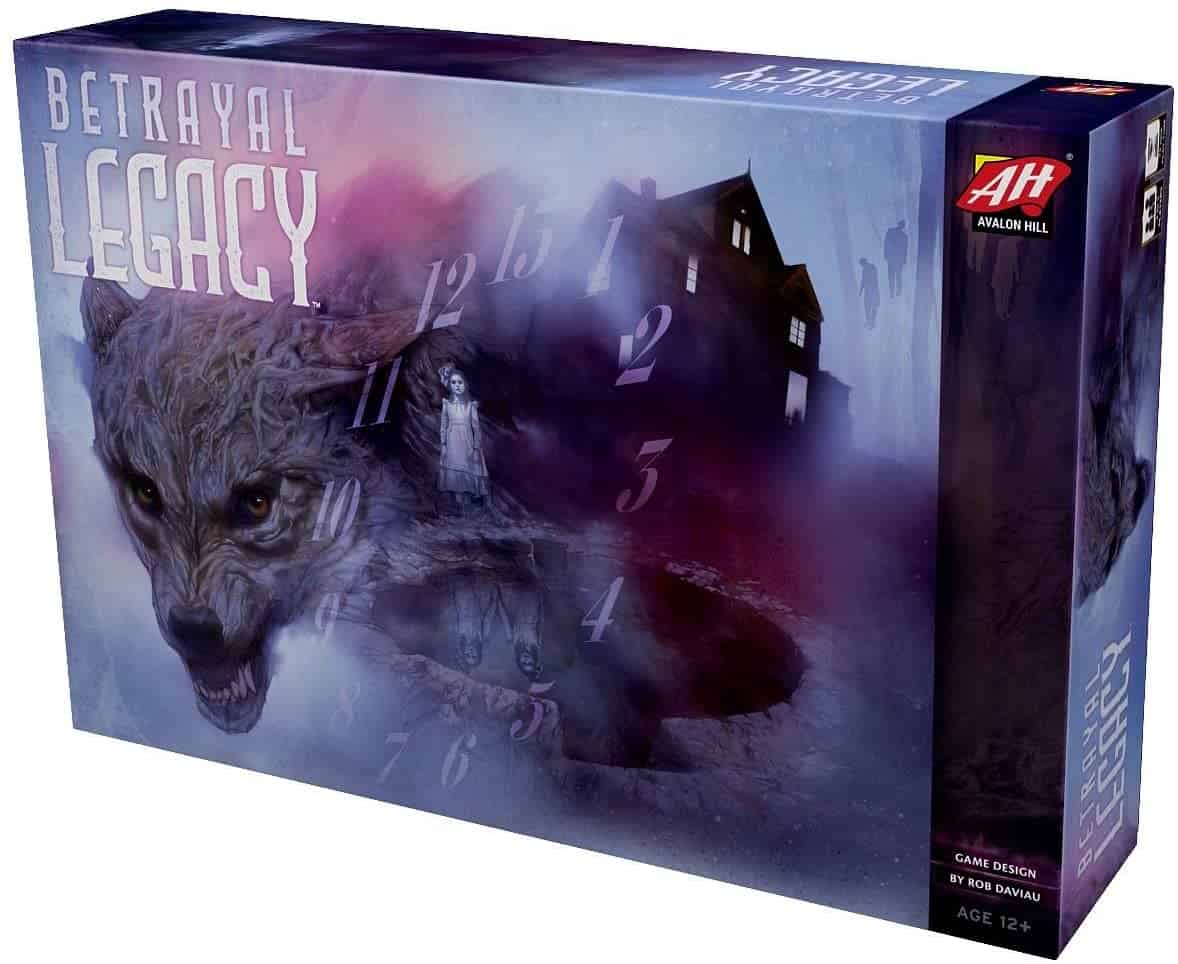
What Is a Legacy Game?
Legacy games have revolutionized and reinvigorated the board game industry, bringing it into the 21st century. That’s no small feat! Basically, these games are designed to change as you play them, so the outcome is never guaranteed, and you can’t be sure where you’ll end up. Because new rules can be added mid-way through legacy games, they have the potential to expand both thematically and mechanically. As a result, each copy of the game will be different at the end.
Let me put it out there: I love legacy games. Seriously, I’m obsessed. Many traditional board games now seem stale in comparison. My first foray into the world of legacy games came when I purchased The King’s Dilemma after a friend recommended it to me, and ever since then, I’ve been converted.
The Origins of Betrayal Legacy
It’s worth noting very briefly that Betrayal Legacy was inspired by another award-winning game called Betrayal at House on the Hill. Both are published by Avalon Games, a company renowned for producing excellent wargames and strategic board games. (Spoiler alert: I think both games are awesome.)
Betrayal at House on the Hill is equally as suspenseful as its successor, allowing players to build their own haunted house room-by-room. All is not as it seems; one of the characters can’t be trusted and must be defeated before it’s too late.
What follows is a nail-biting game of tension, mystery, and betrayal, all of which are carried through into the hotly anticipated sequel of-sorts, Betrayal Legacy.
Betrayal at House on the Hill awards
- 2004 Origins Awards Gamers’ Choice Award Winner
- 2005 Japan Boardgame Best Advanced Game Nominee
Betrayal Legacy awards
- Dragon Awards 2019 Best Science Fiction or Fantasy Board Game Winner
- 2018 Golden Geek Best Thematic Board Game Nominee
- 2018 Board Game Quest Awards Best Thematic Game Nominee
- 2018 Board Game Quest Awards Best Coop Game Nominee
What’s Different in Betrayal Legacy?
- There’s a campaign mode
- Four new terms were introduced: bury, heal, critical, and general damage
- There is an outside reason
- Item and Event cards are only drawn in certain regions
- Some tiles have new features: Runestones, secret passages, ghosts, or multiple symbols
- Turn Item and Omen cards sideways to mark they are used
- Sometimes cards get altered
- What you can do on a turn is organized into actions
- Haunts trigger differently during the campaign
- The haunts use colored boxes to explain your goals

How to Play
Here’s a detailed explanation of how to play Betrayal Legacy.
Aim of the Game
First of all, you’re supposed to spend time exploring the house (yes, you really have to become one of those annoying people in horror movies who never listen when you shout “don’t go in there!”). When the haunt begins, your goal is to first complete your side’s victory as either a traitor or a hero.
How Does the Game Work?
- The whole game is known as a campaign and is played over a series of chapters
- In each chapter, players play as a member of a family
- Each round of the game is self-contained: it starts mostly the same way and continues until there is a winning side
- At the end of the round, players follow instructions to shape the start of the next game
The Legacy Decks
The pre-sorted Legacy decks should never be shuffled; they will guide you through the games. This part always throws me because I’m so used to shuffling cards, but it’s important to resist the temptation.
During games, you will draw a Legacy card, read it aloud, and do what it says until instructed to STOP or PAUSE. At the end of the game, any Legacy cards that have been drawn but not used should be discarded.
The Purgatory Deck
Do not look through this deck (seriously, don’t do it!). As you play, you’ll be instructed to take cards from this deck and add them to one of the other card decks in the game.
Folium Infernum
The Folium Infernum shows thirteen doors marked with a number or letter, each hiding a sticker. You will be instructed to open these doors at certain times during play to reveal the sticker. It’s all very mysterious, and that’s why I love it!
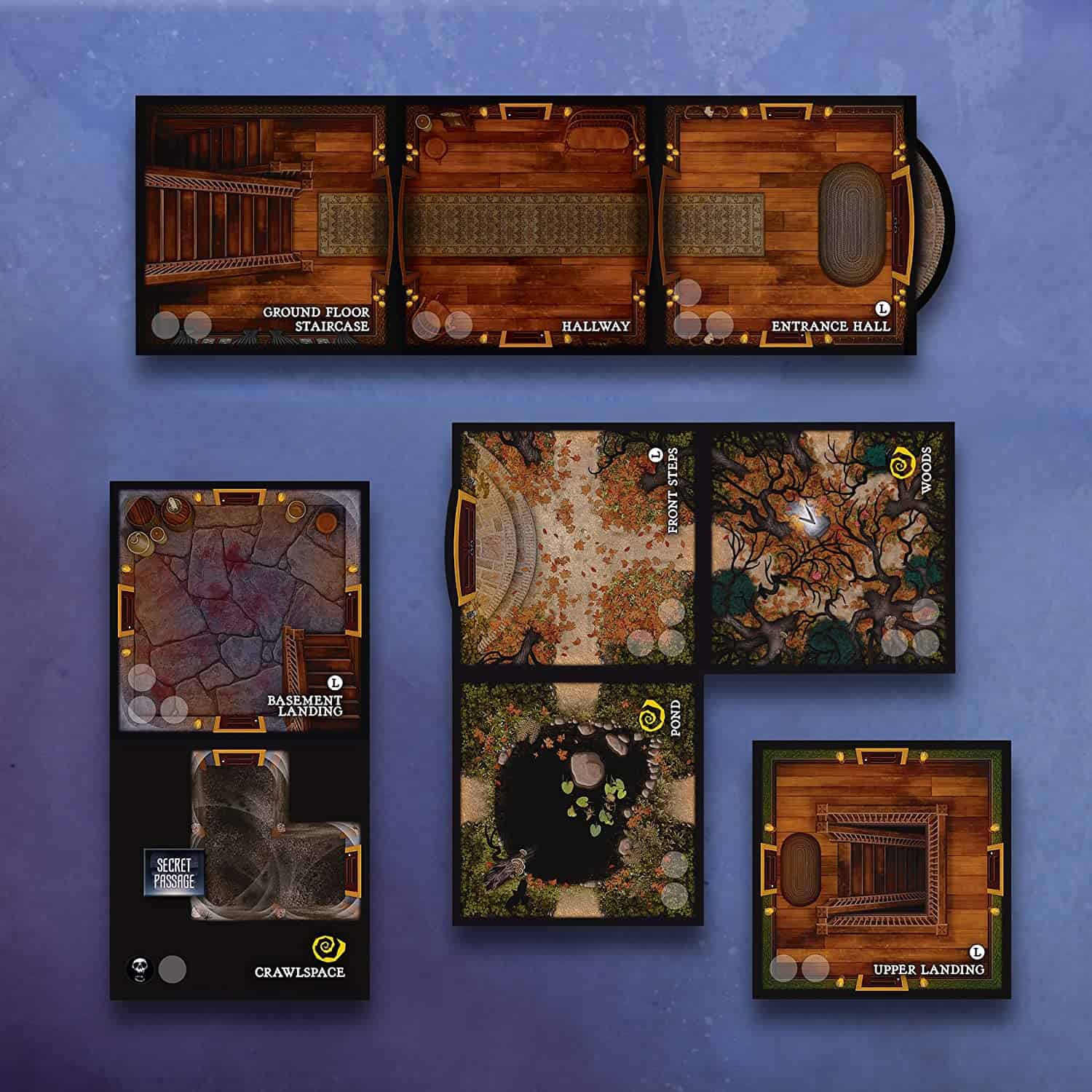
Traitor’s Tome and Secrets of Survival
These books are used when the haunt begins; they give further detail about what is going to happen in your game.
The Bleak Journal
This journal contains letters that will be read throughout the campaign (one of my favorite bits of the game!).
Card Decks and the Tile Stack
The game begins with two decks in play, Item cards and Event cards, and one stack of tiles.
Tile Planks
At the start of certain chapters, the Legacy deck will tell you to add more tiles to the stack from the tile planks to continue building the mansion. You will add many – but not all – of these tiles to your game.
Figures
You’ll play the same family from generation to generation, but you can use any figure for a chapter. Personally, I prefer to stick with the same figure because the game has a better flow that way and it’s easier to become immersed in the story.
Tokens
There are a number of different tokens you’ll need to know about.
- Item pile tokens show when Omens or Items have been dropped on a tile
- Crest tokens – each family has two tokens displaying their family crest
- Searched tokens demonstrate that an action has been performed on a tile or that it has already been searched
- Rune tokens represent different things depending on what haunt you are participating in
- Number tokens mean something different in each haunt and are used for a variety of purposes
- Trait tokens are printed with one of the four traits
- Small/large obstacle tokens show some kind of obstruction in the room
- Small/large Monster tokens represent various creatures in the game
Before You Begin
Before you get to the good bit, you’ll need to spend time getting the game components ready. Boring, but necessary!
- Punch out the tokens, Family cards, and tiles
- Remove the dice, plastic clips, figures, and bases
- Open the starting card deck and sort the Item and Event cards, setting aside the Monster and Traitor cards
- Unwrap the first legacy deck and set it aside without shuffling it
- Unwrap the tile planks without looking at them and place them in the tray, so plank one is on top
- Each player needs to choose a Family card

Setup
Setting up shouldn’t take long, and the good news is that if you’re playing with other people, you can usually persuade them to do it for you. That’s what I usually do, and it works a treat.
In the meantime, I’d recommend spending some time preparing yourself for the horrors that you’re about to experience once the game begins.
- Find your character’s Family card and attach four plastic clips, with each one pointing to one of the starting values (colored green)
- Locate the four starting tiles and place them reasonably far apart on the table to make the regions of the house
- Choose a figure to represent you and put it in a base matching the color of your Family card
- (Campaign only) give your character a name and age, writing it on the back of your Family card without showing the other players
- (Campaign only) each player introduces themself to the rest of the group, stating their character’s age and name
- (Campaign only) read out the text on the top card in the Legacy deck
- (Free play only) shuffle all card decks separately, then shuffle the tiles to make a stack and set out any other cards you may have found
- (Free play only) randomly decide who goes first
Traits
Each character has four traits that are shown on their Family card: speed, might, sanity, and knowledge.
Damage, gaining, losing, and healing
When characters take damage, it causes their traits to decrease. Move the relevant clips down the track a total number of steps equal to the damage.
Type of damage:
- Physical – lower might and/or speed
- Mental – lower knowledge and/or sanity
- General – lower any combination of traits
If you take “one die of damage,” roll the die and take the amount of damage equal to the result.
If multiple people suffer damage at the same time – very unlucky! Start with the player to the current player’s left and continue clockwise.
Critical traits
It is critical when a trait reaches its lowest step before the skull. To be clear, that’s very, very bad, and definitely not a position you want to be in if you can avoid it. I’ve died loads of times in this game, so I’d know.
Raising and lowering from the same effect
Often, effects in the game require you to lose from a trait so that you can gain a benefit. To gain the full reward, you have to be able to pay the full penalty; if you can’t, you don’t get the benefit. That’s life, right? Even in a board game, you can’t escape reality. Damn.
Dice and die rolls
The game comes with eight dice. Each has faces with zero, one, or two dots. When you make a roll, add the dots up to work out the result.
You can’t roll more than eight dice, and you can’t roll fewer than one, no matter how many penalties are applied. (Thank god there isn’t too much adding involved, am I right?).
Trait roll
Often you will need to make a trait roll based on one of your family’s traits. When this happens, roll dice equal to the number you currently have in that trait. The text on the card or tile will tell you the outcome.
Roll a certain number of dice
Some effects tell you to roll a specific number of dice.
Regions and tiles
The house has four regions:
- Outside
- Basement
- Ground floor
- Upper floor
Listen up, because this bit is a little complicated. Tiles are classed as adjacent if they are connected by a doorway or other effect. They also must have been discovered. A doorway that isn’t connected to another tile is an open doorway. Makes sense? Good.

Taking a Turn
Here’s what to do:
- Any Items and Omens you are carrying should be set to unused
- Check your current speed – you gain moves equal to it
- Use moves and take actions until you are out of both or choose to stop
Moving
Moves are usually used to travel to an adjacent tile or move to a new tile. For each tile you leave, you use one move.
Secret passages
What haunted house would be complete without haunted passages? In the prologue, there’s one tile with a secret passage; as you play, you’ll find ways to place Secret Passage stickers on tiles.
Obstacles
Every small obstacle on a tile costs one extra move when leaving that tile. Extra-large tiles, on the other hand, cost two extra moves.
Small Monster tokens count as small obstacles, and, similarly, Large Monster tokens count as large obstacles. By this point, you’re hopefully getting the hang of things.
Discovering a tile
When you exit through a doorway that isn’t connected to a tile, look for the name of the region you are in. You can connect two tiles by aligning a doorway located on a new tile to the existing doorway you just passed through.
Connect as many adjacent doorways as you can. This is seriously one of the most important things to focus on – take it from someone who has played this game way too many times. Connect. The. Doorways.
If the top tile doesn’t fit anywhere in your region, bury it and wait until you find one that does fit.
When players enter a tile that has already been discovered, they don’t draw a card but are still affected by any text on the tile.
Runestones
You can ignore Runestone symbols on tiles unless the haunt specifically tells you not to.
Ghosts
Tiles usually have circles on them that show where ghosts will haunt the house. (And, like any sane person, it’s a good idea to avoid these places – though unfortunately, that isn’t really possible if you want to play successfully). Omens harness ghost energy, so they are more powerful on tiles with ghosts.
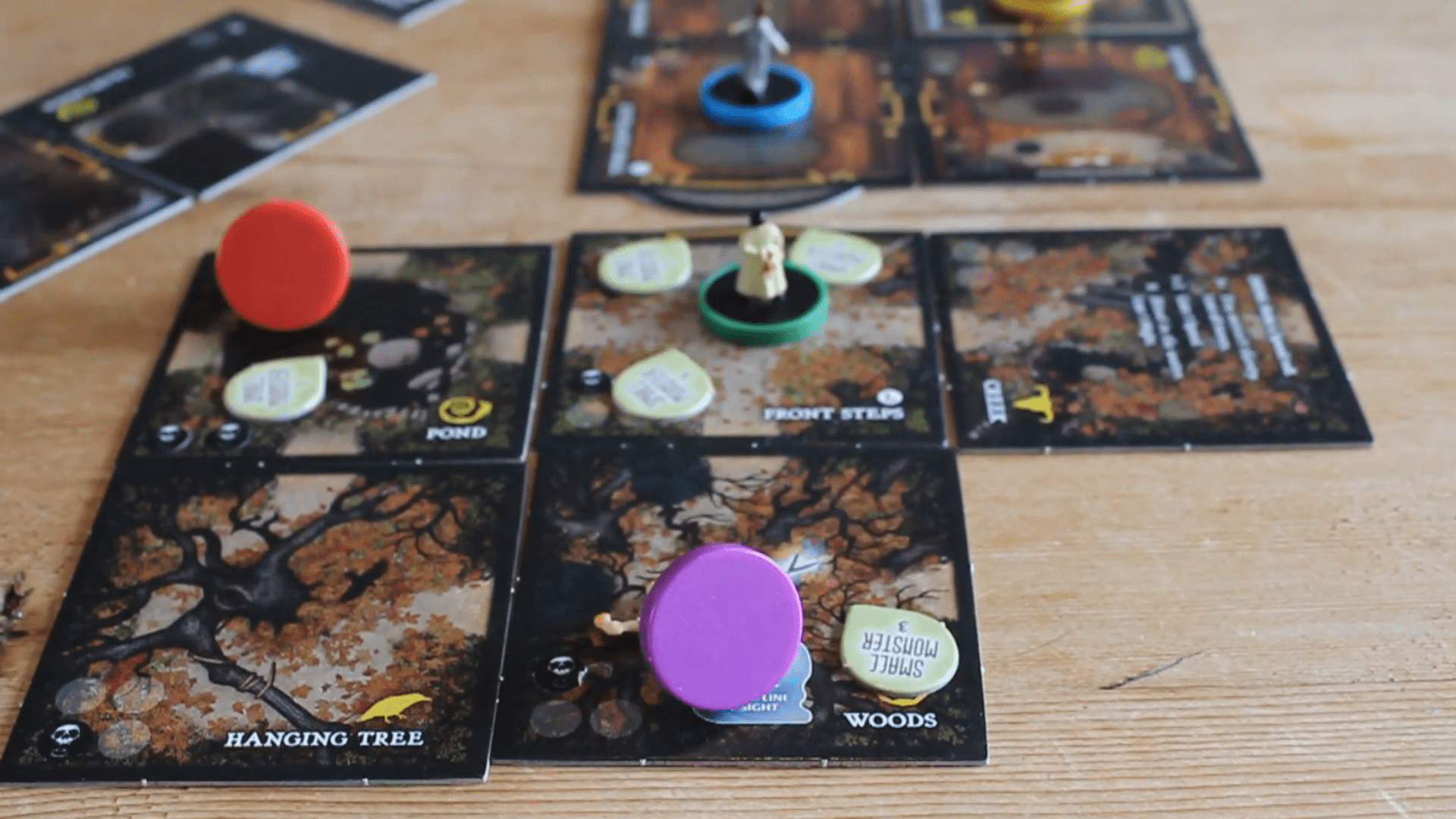
Turn timing when discovering a tile
Resolve in the following order:
- Resolve any symbols from left to right (you can’t take actions during this stage)
- If the haunt hasn’t started and you draw an Omen card, check if the haunt starts now
- You can take any actions printed on this tile
- Any text that says “if you end your turn on this tile..” should be resolved
Cards
When you discover a tile with an Item, Event, or Omen symbol, draw a card.
- When you draw a card, you lose all remaining moves (but not actions)
- If instructed to draw the top card, do so regardless of its region markings
- Read all cards out loud unless they specify otherwise
- You can carry any number of cards; there is no limit
If the top card from the Event deck matches your region, you should draw it. If it doesn’t, keep burying cards until you find one that does. So much of this game is about waiting for the right item or card to come up, but trust me, eventually, it will. You’ve just got to be patient.
Similarly, if the top card from the Item deck matches your region, you should draw it. Otherwise, continue burying cards until you find a match.
Draw the top card from the Omen deck and put it face up in front of you. You now gain any bonuses it gives.
Draw an Event card when you discover a new tile with the Event symbol on it, and sometimes as the result of another effect. Usually, Event cards are buried after you read them. Ongoing Event cards have continuous effects, so they should not be buried.
Item and Omen cards
You draw these cards when you discover a tile with a matching symbol. Finally, you’re in luck! Both represent things you can carry and use, but Omen cards might trigger the haunt and interact with ghosts.
Item and Omen cards have two states: unused (turned straight up) and used (turned sideways).
Heirlooming Item cards
Each family has nine heirloom stickers, which I think is a really cool part of the game. When you draw a card that has a space for one of these stickers, you must decide whether to make it a family heirloom. If you decline, you can’t go back on your decision later in the game.
Objects
During haunts, certain tokens will become Objects which can be picked up, dropped, given, taken, and stolen.
Actions
As soon as you find an Omen or Item, you gain access to all actions on your family card other than attack. You can only take these actions when you are carrying Items and Omens, and they are unused.
Common actions:
- Give as many unused Items and Omens as you want to another player on your tile
- Drop as many unused Items and Omens as you want on your tile (set aside the cards you used, face-up)
- Take any number of unused Items and Omens from other players on your tile
- Pick up on a tile with an Item Pile token, taking as many cards under the matching numbered Item Pile tokens as you like
Attack
Players get access to the attack action when the haunt begins. (Yes, at last! Now the fun really begins) You can’t attack before the haunt starts.
Unarmed attack:
- Choose a target on your tile
- You need to roll a number of dice equal to your level of might
- After your roll, your target then rolls dice equal to their might
- The character with the lowest result takes physical damage equal to the difference between the two rolls
- The person who rolls highest is said to have succeeded in combat
Monsters aren’t killed when you attack them, only stunned, unless the haunt says otherwise. This is a pretty brutal rule because it makes the game so much more difficult, but that’s also part of the fun.
Other attacks:
- Items and Omens marked as Weapons give alternative attack actions
- This attack could use a trait other than Might: Might and Speed attacks deal physical damage, whereas Knowledge and Sanity attacks deal mental damage
- You can’t use a trait to attack an opponent who doesn’t have that trait
Line of sight
This is a path that leads through an uninterrupted straight line of doorways in the same region. Players are allowed to make line of sight attacks if an effect or Weapon says so.
Steal
Stealing counts as a successful attack. If you attack someone on your tile and you would deal two or more damage, you can choose to forgo damage and instead steal your choice of one Item, Omen, or Object. Your friends will forgive you…one day. Maybe. If they don’t hold grudges, which I definitely do.
Monsters can’t steal or be stolen from unless the haunt says otherwise.

The Haunt
Every time you draw an Omen card, you risk triggering the haunt.
When you make a haunt roll, you need to count the number of discovered Omen cards and roll dice equal to that number. Looking at the PAUSE card will reveal what result causes the haunt to begin during the campaign. The player who initiates the haunt is known as the haunt revealer.
Initiating the haunt
- Haunts can be found in two books, Secrets of Survival and Traitor’s Tome
- Most haunts have a team of heroes and a traitor who works against them
- Both sides check their books and read the same haunt number to find out the rules
- If multiple people may be the traitor, draw a random Crest token from tied families to work out who it will be
- The target numbers involved in haunts vary depending on the number of players
- Thematic book entries tell you the story of what is happening
- You might have to set up the haunt by putting tokens on tiles or finding a tile that hasn’t been placed yet
Now, the two groups split up. One side should take their book and leave the room; the traitor usually learns their haunt alone. This sounds difficult, but in my experience, being the traitor is actually more enjoyable than being one of the heroes.
Each side should read how to win, including the goals that need to be satisfied and which order they should be completed in. You will see the main goal and the side goal.
Resuming the game
- The first turn is taken by the hero to the left of the traitor
- The traitor goes last, and play continues to the left
- If there is a Monster, the Monster’s turn comes after the traitor
If there is no traitor in a haunt or the traitor is hidden, the haunt will tell you who goes first.
Moving past opponents
Opponents act like small obstacles in the haunt.
The traitor
The traitor acquires a number of benefits:
- You ignore Obstacle tokens
- You don’t acquire any damage from tile effects
- You can use a result of five rather than making a roll when taking action on a tile
- You don’t have to draw an Event card when you discover an Event tile
- You are allowed to ignore harmful events from Ongoing Event cards
- Negative ghost effects cannot harm you
Monsters
Monsters behave differently from players because they only take a turn when play reaches the Monster card. Monster abilities include:
- Don’t take damage from tile effects
- Make a Speed roll at the start of their turn to determine their moves
- Can’t discover new tiles
- May use special movement on cards or tiles
- Can’t carry or steal Items, Omens, or Objects
- Don’t take actions except for what the haunt says they can take
Most Monsters can’t be killed; instead, they are stunned when they take damage. Flip the Monster token to the stunned side. A stunned Monster’s entire next turn is spent getting unstunned. It’s a slow and frustrating process, but great news for the brave heroes.
Dying
When the haunt begins, you automatically die if any of your traits moves to the skull position This has happened so many times to me. Tip-over your figure on your tile, then drop all your Items, Omens, and Objects. You are a corpse.
Winning the Game
The first side to complete its goals for the haunt wins the game.
Final steps
- Read the chapter-ending relating to the side that won the haunt
- The ending will tell you which cards from the Purgatory deck to add or intensify
- Record your fate
- Return cards
- Record the history of the house in the final three pages of the Traitor’s Tome
Who Is Betrayal Legacy for?
Betrayal Legacy is recommended for three to six players aged twelve years and over. You don’t need to have any existing knowledge of Betrayal at House on the Hill to enjoy Betrayal Legacy; the two games can stand alone.
To be honest, I wouldn’t describe Betrayal Legacy as a family game – the recommended age is too high, and horror games aren’t for everyone – but fans of the genre will surely find this game to be one of the most enjoyable.
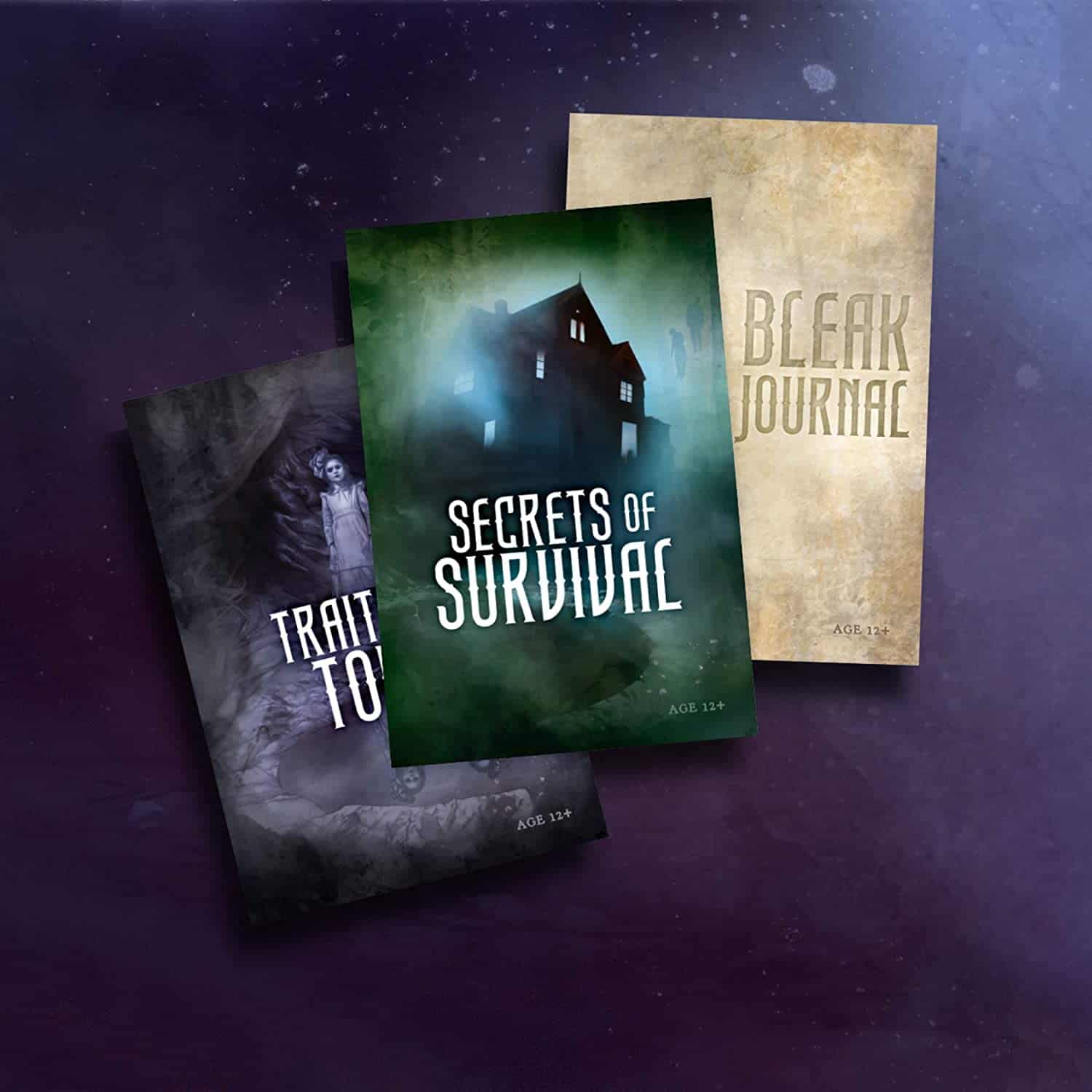
Betrayal Legacy Components
- 1x sealed box
- 1x sealed envelope
- 2x haunt books
- 1x Bleak journal
- 1x sticker sheet
- 1x Folium Infernum
- 12x tiles
- 1x numbered track
- 5x plastic family figures
- 5x colored plastic bases
- 5x Family cards
- 20x plastic clips
- 8x dice
- 7x Item cards
- 11x Event cards
- 1x Traitor card
- 1x Monster card
- 2x Legacy decks
- 1x Purgatory deck
- 20x tile planks
- 122x tokens
- 1x rulebook
Betrayal Legacy Alternatives
Here are some other games I’d recommend.
The King’s Dilemma

The King’s Dilemma is my all-time favorite legacy game. If you like Game of Thrones, you’ll love this strategy-based board game that requires persuasion and deception to bring about an outcome for the Kingdom that suits your house’s ambitions. You have the King’s attention…what will you do with it?
Find out more about this epic legacy game in our King’s Dilemma guide.
- Players – 3-5
- Recommended age – 14+
- Playing time – 45-60 minutes per game
13 Dead End Drive
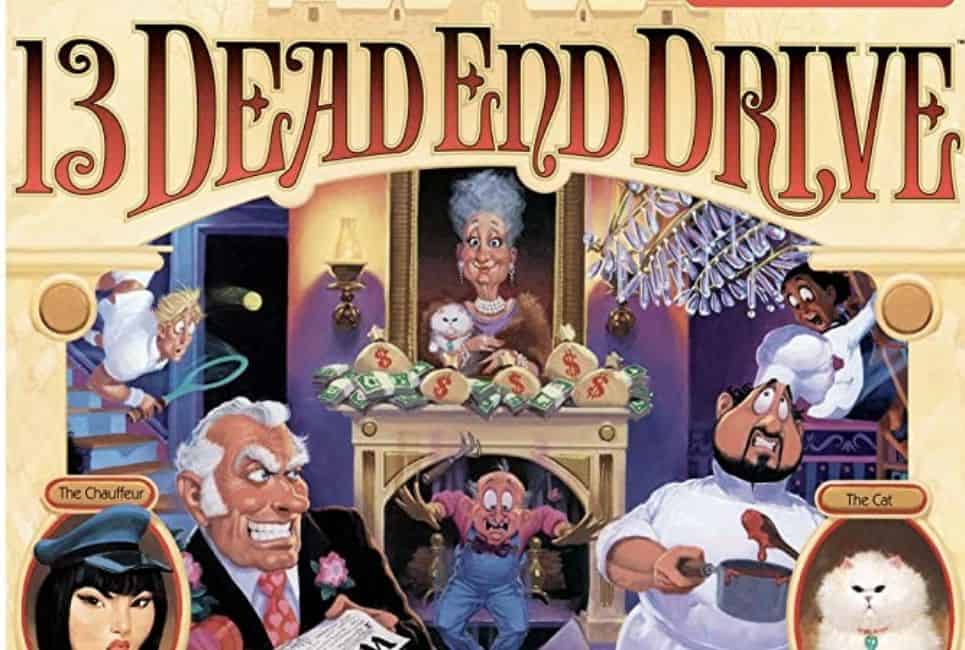
13 Dead End Drive ticks all the boxes we avid horror fans love to see: a haunted house, a fortune to inherit, and a heck of a lot of mystery! It’s similar to Betrayal Legacy but doesn’t last as long and is suitable for younger children. Overall, an amazing family game.
Read more in our 13 Dead End Drive guide.
- Players – 2-4
- Recommended age – 9+
- Playing time – 45 minutes
Frequently Asked Questions
Question: What if I can’t figure out a rule in Betrayal Legacy?
Answer: Betrayal Legacy has many interesting combinations of effects, and the rules change as the game progresses. Here’s some information for when you’re not sure:
• Rules in haunts take precedence over other rules
• Rules on cards or tiles take precedence over those in the rulebook
• If you find a single rule, card, or effect that gives you an unexpectedly powerful moment, that probably isn’t its intention
• Any effect that seems unfair has probably been incorrectly interpreted
Question: Can you play Betrayal Legacy solo?
Answer: The game relies on teams, so it isn’t possible to play solo. We have a guide to the best solo board games that you might find helpful.
Question: What is The Bride’s Diary?
Answer: The Bride’s Diary is an object. It can’t be stolen.
Question: What happens when you banish the bride?
Answer: You win! You may find The Bride’s Diary, read it to improve your chances, then banish the bride to bring her final rest.
Question: How many times can you play Betrayal Legacy?
Answer: You will play 14 different time periods of chapters throughout the campaign. Players can reuse characters or create a new family descendent after each chapter.
Recommended Reads:
- Best Campaign Board Games
- The 30 Best Strategy Board Games for Every Player
- Lost Ruins of Arnak Guide
- Stratego Pieces Explained – Must-Know Facts - February 28, 2023
- Wahoo Board Game Guide – AKA Aggravation Guide - February 22, 2023
- Pokemon Monopoly Guide - February 22, 2023

